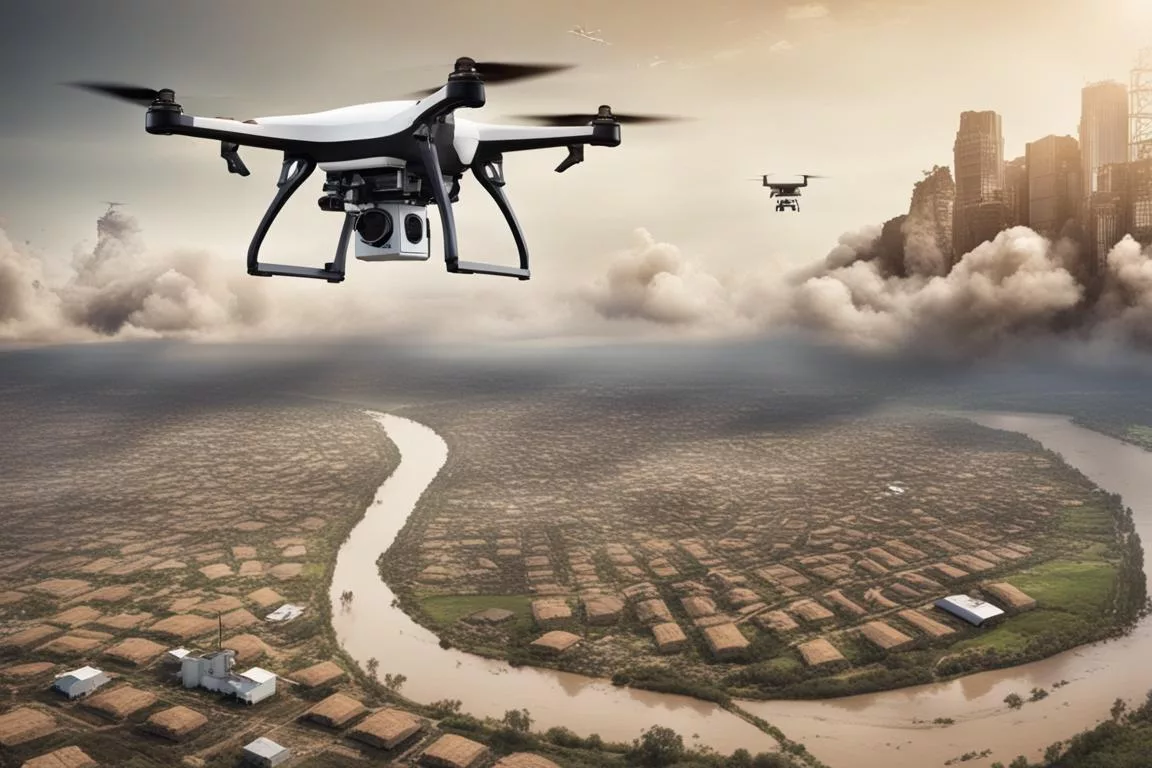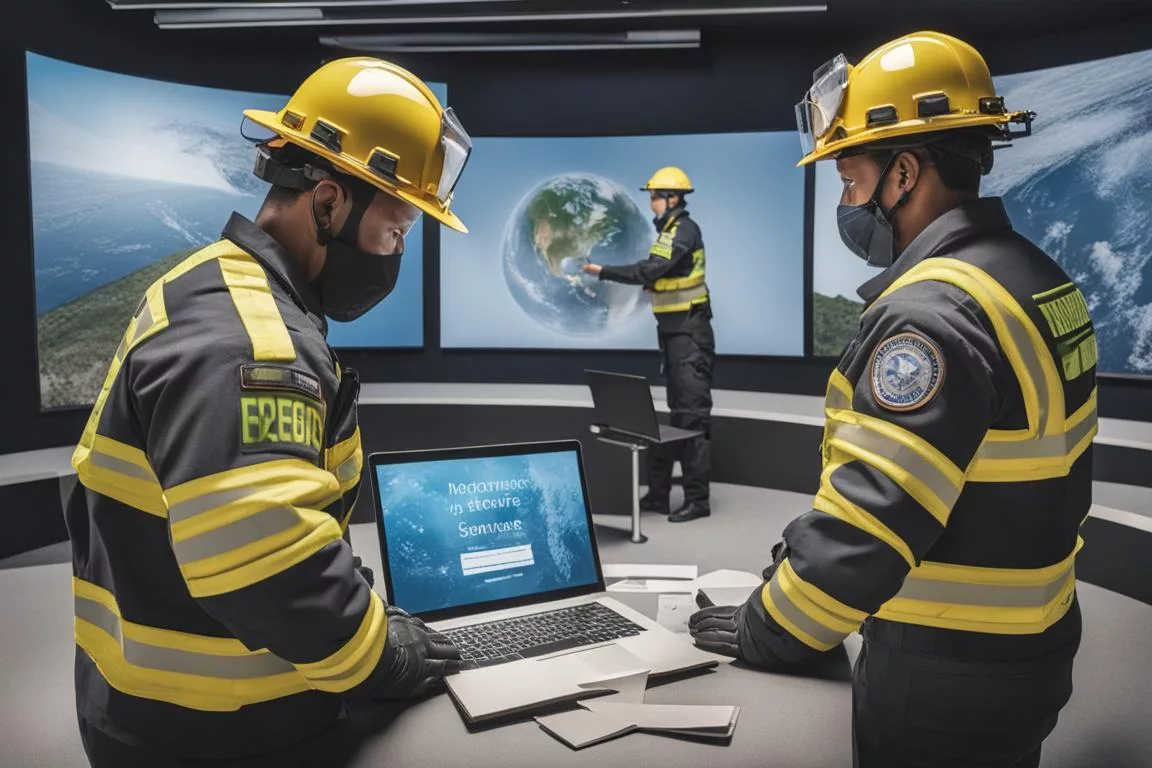Let’s cut to the chase: the ways we’ve traditionally responded to disasters are being revolutionized by technology. As someone who’s passionate about both tech and environmental conservation, I’ve seen firsthand the transformative power of innovative tools in the face of calamity. It’s not just about improving efficiency or cutting costs it’s about saving lives and preserving our world. So, let’s delve into the specifics of how technology is reshaping disaster response and relief. And trust me, it’s impressive.
How Technology Aids Disaster Response
By reading this article, you will learn:
- Drones are used for damage assessment and search and rescue operations in disaster areas.
- Social media helps in communication, coordination, and gathering real-time information during disasters.
- Big data enables predictive analytics, aiding in disaster preparedness and response.
1. Drones

Few technologies evoke the future quite like drones. These aren’t just toys for capturing breathtaking aerial shots; they’re pivotal in disaster scenarios. I remember the awe I felt watching drones deliver medical supplies after a devastating earthquake. They reach areas where traditional vehicles falter, offering real-time visuals to rescue teams and mapping safe paths through debris.
Insider Tip: Drones are increasingly equipped with thermal cameras to find survivors trapped under rubble by detecting body heat.
Drones are the epitome of tech meeting human need in the most dire situations. With their birds-eye view and nimbleness, they’re transforming search and rescue operations into precision-driven tasks.
2. Social Media
Social media is not merely a platform for selfies and food pics; it’s a lifeline during disasters. When phone lines are down, and chaos reigns, platforms like Twitter become hubs for real-time information sharing. Personal anecdotes aside, the stats speak volumesstudies show that emergency services significantly benefit from the crowd-sourced intel on social media.
Insider Tip: Hashtags have become crucial in organizing relief efforts and spreading critical information swiftly.
In your moments of need, social media stands as a beacon of hope, connecting you with help and your loved ones. It’s community and technology interwoven to form a safety net that’s both personal and powerful.
3. Big Data
Big data is not just a buzzword; it’s a game-changer in disaster management. Imagine harnessing the sheer volume of data from satellites, sensors, and survivors to predict and respond to disasters. This isn’t science fictionit’s happening now.
Insider Tip: Advanced algorithms analyze patterns to forecast disasters, giving us precious time to prepare and respond.
I’ve seen big data turn what seemed like chaos into actionable insights, guiding relief efforts with precision. This is where technology feels like a superhero’s ally, crunching numbers to save the day.
4. Virtual Reality

Virtual Reality (VR) is not just for immersive gaming experiences; it’s a training ground for disaster preparedness. I’ve worn those headsets, stepping into simulations that feel unsettlingly real. First responders can now train in virtual environments that mimic the unpredictability and danger of disaster zones without the risk.
Insider Tip: VR scenarios are being tailored to specific types of disasters, making the training even more relevant and effective.
VR is the bridge between theory and reality, where responders can hone their skills to ensure that when disaster strikes, they’re not just readythey’re experienced.
5. Chatbots
Chatbots might seem like a convenient way to track your online shopping, but in disaster scenarios, they’re a critical communication tool. I recall interacting with a chatbot during a flood warning; it provided updates, safety tips, and even connected me with local emergency services.
Insider Tip: Multilingual chatbots are becoming essential in diverse communities, breaking down language barriers in critical times.
This blend of AI and compassion offers a 24/7 helpline that’s both informative and reassuring. Chatbots are the unsung heroes, tirelessly working behind screens to keep you safe.
Read more: The Environmental Impact of Generative AI
6. Blockchain
Blockchain is often touted for its financial applications, but its implications for disaster relief are profound. The technology ensures that aid reaches its intended recipients without the interference of corruption or bureaucracy. I’ve tracked donations via blockchain, witnessing the transparency and speed at which aid is delivered.
Insider Tip: Blockchain is being used to create secure, immutable records of land ownership, crucial in rebuilding efforts post-disaster.
In this digital ledger, trust is paramount, and accountability is the default. Blockchain is not just about cryptocurrenciesit’s about cultivating a culture of integrity in disaster relief.
7. The Internet of Things (IoT)
The Internet of Things (IoT) might sound like tech jargon, but it’s a vast network of connected devices that can revolutionize disaster response. Sensors in buildings that detect structural integrity or wearables that monitor health vitals can be lifesavers when every second counts.
Insider Tip: IoT devices are being deployed to automatically shut off utilities like gas and electricity to prevent further hazards after a disaster.
IoT is the silent sentinel, always on guard, ready to alert us to dangers we can’t see. It’s the embodiment of being proactive rather than reactive in the face of disaster.
8. Artificial Intelligence (AI)
AI is not just about robots; it’s a critical component of disaster response. Predictive analytics powered by AI can forecast disaster impacts, aiding in evacuation and relief planning. I’ve seen AI systems process satellite imagery to assess damage faster than any human could.
Insider Tip: AI is being trained to recognize distress signals in social media posts, even those not explicitly asking for help.
AI is the powerful ally working tirelessly behind the scenes, sifting through data to protect and serve humanity when nature unleashes its fury.
Case Study: Humanitarian OpenStreetmap Team (HOT)
The Humanitarian OpenStreetMap Team (HOT) plays a crucial role in responding to natural disasters by providing fast and reliable geospatial information to aid organizations and first responders. Through rapid response activations, the HOT community collaborates online to generate map data using satellite and drone imagery, which is then made available via the Humanitarian Data Exchange (HDX) for analysis and navigation on the ground. HOT’s work is global in scale and contributes to the achievement of the Sustainable Development Goals by revolutionizing disaster management, reducing risks, and fostering an active culture of humanitarian mapping. The organization’s impact is evident in its involvement in numerous disaster response projects around the world, such as post-earthquake response in Haiti, flood management in Ivory Coast, and cyclone response in South Asia. By leveraging open mapping and innovative technology, HOT effectively supports and enhances the resilience of communities facing natural disasters.
The Humanitarian OpenStreetMap Team (HOT) utilizes satellite and drone imagery to rapidly respond to natural disasters. This approach enables the generation of crucial map data, which is then made available for analysis and on-the-ground navigation via the Humanitarian Data Exchange (HDX). The use of satellite analytics is evident in various disaster response projects, such as post-earthquake response in Haiti, flood management in Ivory Coast, and cyclone response in South Asia. Additionally, HOT’s collaboration with organizations like Microsoft for the “Satellite Imagery for Social Good” project in Kenya and Nigeria demonstrates the effective use of satellite imagery for humanitarian mapping initiatives. By leveraging satellite analytics, HOT significantly enhances the speed and accuracy of its disaster response efforts, ultimately aiding in the prioritization of aid and the overall resilience of affected communities.
Conclusion
In the ever-evolving landscape of disaster response and relief, technology is not just a tool; it’s a transformative force that brings hope and resilience. From drones to AI, these advancements are not just cool gadgets or platforms; they are the embodiment of human ingenuity in the service of our most vulnerable moments. As someone who’s witnessed the intersection of technology and disaster response, I can tell you that the stories of lives saved and communities rebuilt are not just heartwarmingthey’re testaments to the power of technology wielded with purpose and compassion.
It’s not about replacing human responders; it’s about empowering them with the tools to act swiftly, smartly, and safely. So, the next time you see a drone overhead or receive an alert from a chatbot, remember that these are the harbingers of a new era in disaster managementone where technology stands as a steadfast ally in our fight against the unpredictable forces of nature.
Next Steps
Round Table Environmental Informatics (RTEI) is a consulting firm that helps our clients to leverage digital technologies for environmental analytics. We offer free consultations to discuss how we at RTEI can help you.


